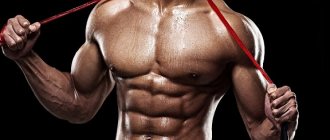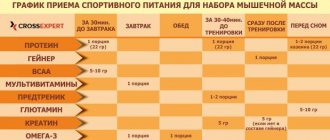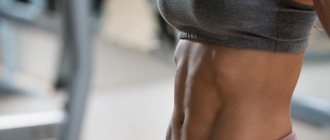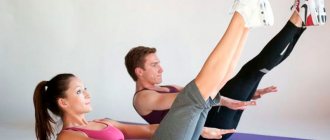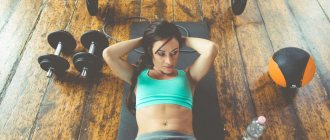- October 11, 2018
- Workouts in the gym
- Alexey Smirnov
In today's world, as in all times, there are representatives of both male and female who actively monitor their appearance and figure. As for men, many would like a beautiful and attractive physique, which may have helped them somehow realize themselves with the help of this. Apart from muscles, it is also nice to have nice and firm abs.
The best abs in the world from Jay Cutler
Tags: abs, Cutler
Billy DeConcini
Everyone has abs; many people just hide them under a thick layer of fat. It can only be shown when the level of body fat is low. In order to make a splash on the beach, you need to constantly “be in shape.” Although in bodybuilding the concept of shape implies more than just a clearly defined six-pack, this stage of physical development is considered a priority. The abs are the foundation on which the rest of your figure is built. This month we're taking a look at the ab workouts done by true mass monster Jay Cutler. Ab problems are not often discussed when it comes to athletes like Lee Priest, Ahmad Haidar, Durrem Charles, Melvin Anthony and the like. When was the last time you read about Ronnie or Ponter's ab workouts? Jay is perhaps the only mass monster who can match the quality of his abs with athletes who are 25 kg lighter than him. Before we look at the training program itself, let's take a closer look at this challenging muscle group.
The only correct technique?
If your abs don't cause a series of swoons all around you when you pull off your shirt, then you're probably on the wrong path to building them. This is the most widespread misconception. No part of the body is shrouded in such a huge number of myths and fictions as the abs. Meanwhile, in order to build it, you need to know only a few basic principles and not waste time on useless activities.
Is there local fat burning?
The most common stupidity is local fat burning. This fiction is responsible for millions of hours spent doing tedious crunches and leg raises. The gist of it is that abdominal exercises supposedly burn fat specifically in the abdominal area, allowing you to “show off” the coveted six pack. But physiologically this is impossible; the human body simply does not work according to this scheme.
The body begins to get rid of fats only when the demands on its activity increase. Fat reserves (including around the waist) are stored as sources of energy in case the metabolic system suddenly stops receiving the amount of carbohydrates, proteins and fats adequate to the costs. That is, extra calories received from food are stored “in reserve.” If there are enough calories for normal functioning, why does the body need to print its fat depots? Years of evolution have adapted humans to long periods of malnutrition or starvation. Fat from the waist will not go away until there are adequate incentives to use it.
Diet and exercise are the most effective means of increasing energy use. Calorie consumption should not exceed their expenditure. Exercise, both aerobic and anaerobic, speeds up your metabolism and increases your energy needs. In conditions of calorie deficit from nutrition, the body is forced to borrow energy from its own reserves, that is, from fats. A thousand crunches a day will certainly increase the strength and endurance of your abdominal muscles, but the results will not be noticeable from the outside if your abs are hidden under a layer of fat. A proper diet and exercise for the whole body is the way to a beautiful waist.
Should you train your abs every day?
The frequency of abdominal training is another burning issue, and a look at the training programs of professionals does not clarify it much. The range of techniques is wide - from Jay, who loads the abs every day, to Dexter Jackson and Lee Priest, who do not train the abs at all.
Although we have long known that the rectus abdominis muscle is exactly the same skeletal muscle as the rest, there are people everywhere who do hard work on their abdominal muscles every day. Training any muscle every day is a direct path to overtraining and completely stopping progress. However, such a practice can be justified. Jay Cutler, for example, is confident that daily abdominal workouts keep his body in good shape.
To keep your abs in shape and not lose strength, you can load them twice a week or every other day. Whichever scheme you choose, to stimulate abs development you need to train them hard. At the same time, common sense dictates that the abdominal muscles also need adequate rest to recover, and this can take from 24 to 72 hours or even more, depending on the intensity and duration of the workout and individual recovery abilities. At a high intensity, but not overloading the body’s recovery capabilities, two to three times a week is more than enough. However, if you still want to repeat the training programs of professionals, you can try. The main thing is to avoid overtraining.
Body sit-ups and nothing else?
The sit-up is an effective exercise for the hip flexors, but it doesn't do much for the rectus abdominis (except at the bottom of the range where the abdominal contraction occurs). To fully develop this area, other exercises are required. Indeed, in addition to the rectus abdominis muscle (actually the “six pack”), there are also external and internal obliques, as well as the transverse abdominal muscle. You can’t work out all of them in one movement—you need variety, and that’s why we’ll see three exercises in Jay’s arsenal.
How long does it take to pump up your abs?
A trainer or nutritionist cannot answer how quickly you can pump up your abs to a six-pack. Each organism is individual. It is important to follow a healthy diet and exclude harmful foods. With intense training in men with a low level of excess subcutaneous fat in the abdominal area, the effect is noticeable after a month and a half. If you are overweight, the period will increase - part of the time will be spent on tightening the abdomen and strengthening the stretched muscles.
The key to the appearance of attractive six-pack abs in a man will be compliance with nutrition, rest regime between workouts, and technical skill in performing exercises. Maintaining the result is achieved by stable work on the abdominal muscles in the future. Abdominal muscles with cubes are beautiful and useful - they act as additional protection for internal organs.
Jay's program
Crunch (ZH15-20)
Jay lies down on the bench so that his head, trapezius and deltoids hang over the edge - this provides a stretch for the abdominal muscles. Keeping his hands at his temples (so as not to help his head and upper body), he twists his torso towards his hips. The knees are bent and the repetitions are performed quickly.
Lying leg raises (3×15-20)
With his hands on the edge of the bench behind his head, Jay begins to lift his legs from a position where they are below the level of the bench, which provides an additional stretch. Keeping his legs slightly bent, he lifts them towards his head, simultaneously lifting the pelvis and avoiding the perpendicular position of the hips to the torso. He then lowers his legs to the starting position and repeats the movement.
Side crunches (3x15x20)
Lying on his side with his legs crossed, Jay performs lateral torso raises, powerfully loading the obliques. One hand is placed behind the head, the other can rest on the floor for support.
Cardio
A conversation about building abs would be incomplete without talking about cardio training. Is there anything more boring than cardio? However, sculpted abs are achieved through the use of three tools - exercises to develop abdominal muscles, a well-balanced diet aimed at burning excess fat, and aerobics to speed up metabolism and destroy fat reserves.
Aerobic exercise is any activity that increases the body's need for oxygen. Aerobics is good for the heart, lungs, muscles, circulatory and endocrine systems. It serves as a good means of preventing cardiovascular diseases. There are three main criteria for aerobic training - intensity, duration, frequency.
Intensity
Intensity is the level or degree of difficulty of an exercise. Aerobic work should be performed in the range from 55 to 65% of the maximum heart rate (HR-max), then it will be aimed specifically at burning fat. Below we provide a table for calculating heart rate for different ages.
Exercises for diastasis
Vacuum. As you exhale, pull your stomach in strongly and hold in this position for 10-15 seconds. Then take a shallow breath in through your chest and exhale again, drawing in your stomach. This exercise can be performed lying down, sitting or standing. It is useful to do it during the day at every opportunity.
Gluteal bridge. Lie on the floor, bend your knees, feet on the floor shoulder-width apart. Lift your pelvis up, but do not arch in your lower back, squeeze your buttocks and strain your abs. Breathe through your chest during the exercise. Do 20-30 repetitions for 3-4 approaches.
The problem of diastasis should not be ignored. Separation of the rectus abdominis muscles can result in various types of hernias, cause intestinal strangulation, curvature and diseases of the spine. Therefore, if you suspect this problem, try to solve it as early as possible. We hope these tips help you.
The most pumped up man in the world
In order to name the most inflated man in the world, you will have to take a short excursion into history. So, it’s the middle of the last century—comics with muscular heroes are in vogue. Looking at the painted athletes, young people began to pay maximum attention to their bodies.
It was then that the first competitions began to be held among the most inflated people - and since then the best bodybuilders have been competing for the title - “Mr. Olympia”. Today we will tell you about the brightest men who have ever taken part in this competition.
Markus Ruhl
Date of birth: 02/22/1972. Germany – Darmstadt. From childhood, the boy grew up surrounded by loving family and friends. The young man became interested in bodybuilding quite late - at the age of 19. He did not have any objective reasons, such as fighting off offenders or asserting himself. And he came to the rocking chair, rather out of curiosity. After four years of intensive training, Marcus wanted to take part in the Championships held in Hesse, however, the young man’s plans were hindered by a shoulder injury.
Ruhl received his first medal in 1995 at a competition in Babenhaus. Four years after this event, the athlete was invited to take part in Mr. Olympia. True, according to the results, Rule did not even make it into the top ten, but Marcus, who has a cheerful disposition, did not consider this a loss, but, on the contrary, considered the very fact of being invited to an event of this kind an achievement.
Thanks to the support of his family and loved ones, in 2002 Marcus took first place in the “Night of Champions”. As fans and critics later recalled, as soon as Rule appeared on the stage, all doubts disappeared - only he could become the winner of this tournament. Marcus then said: “This is the only time the judges appreciated me and put me in the place I deserve.”
This athlete, despite all his hard work and perseverance, rarely stood at the top of the podium, but wherever he participated, he presented himself as a worthy competitor and a serious opponent.
Anthropometric data of this most inflated man in the world:
- Height -177
- Weight – 127
- Chest -148
- Biceps – 57
- Hip – 84
Lee Haney
Date of birth – 11.11. 1959. South Carolina - Spartanburg. This most inflated man in the world managed to climb to the top of the Mr. Olympia podium eight times! It was he who created the exercise aimed at working the back of the deltoid muscles - the “Haney Row”.
Lee was fond of sports from early childhood - at first his love was football, but then the boy thought and decided that he wanted to be big and strong - and at the age of 19 he won his first victory in the youth Mr. America.
It must be said that the boy grew up in a religious family and was very devout himself - at the age of 17, he promised the Almighty to dedicate all his victories to him. And since then, higher powers have always been on the side of the athlete.
Ronald Dean Coleman
Date of birth: 05/13/1964. Louisiana - Monroe. Another eight-time winner of the Mr. Olympia title. This man showed himself to be the owner of iron willpower, endurance and decisive character.
Since childhood, the boy devoted all his time to football, baseball and basketball. Thanks to regular exercises, he already looked quite impressive at the age of twelve. Once he made a choice in favor of higher education, Coleman abandoned the rocking chair. However, after receiving a degree in accounting, Ronald realized his mistake and joined the police.
Coleman liked working in the police much more and in order to maintain his shape, he returned to the gym. And in the gym his fate was decided - the owner of the gym asked Ronald to try his hand at “Mr. Texas”. The offer included a free annual membership to the fitness center, and the young policeman didn’t think twice about it. That tournament revealed to the world the new most pumped up man in the world.
After this there were a number of victories - photographs of Ronald Dean Coleman began to adorn the pages of the most popular sports magazines. Two films were made based on the athlete’s career - they tell about the progress of daily training and the process of preparing for Mr. Olympia.
Ronald retired from professional sports eight years ago and now lives as a reserve officer in Arlington with his wife Vicki Grace and two daughters.
Jay Cutler
Date of birth: 08/03/1973. State of Massachusetts. Jay is the son of a farmer and has been exposed to hard physical labor from a young age. So the base for muscle building was more than decent. The future champion began to seriously engage in bodybuilding at the age of 18. But the first year of classes did not produce tangible results - many mistakes were made.
Realizing that a huge number of exercises and their repetitions did not produce a visible effect, Cutler began to study the theory. The results were not long in coming - at the age of 20 he won the NPC Iron Bodies Invitational. A couple of years later, Jay took first place in the “Night of Champions” tournament and thereby attracted the attention of the right people - Jay Cutler set out on the path of professional bodybuilders.
Hard work and regular training did their job - in 2006, this most pumped-up man in the world removed the mighty Ronnie Coleman from the pedestal. Subsequently, Jay won Mr. Olympia three more times.
Phil Heath
Date of birth: 12/18/1979. USA - Seattle. Young Phil's first hobby was basketball - I must admit, he reached certain heights in it. However, the professional career of a basketball player may be hampered by his short stature - Heath decides to leave basketball and directs his feet straight to the rocking chair. Having enlisted the advice of experienced people, the 23-year-old athlete became the winner in his weight category during the Northern Colorado Championships. Jay Cutler became a mentor and good friend of the future most pumped up man in the world.
A year after his successful performance, Phil becomes the owner of the Mr. Colorado title, and then the winner of the Junior Nationals - 2005. Three years later, Phil tries his hand at Mr. Olympia, where he takes third place.
In 2011, the student surpasses his teacher and becomes the Olympia champion. To this day, Phil is the current champion, confirming his title every year since 2011.
This is not a complete list of the most inflated people - it will be further expanded. Some people lose their form and leave, while others still have everything ahead. New people come to bodybuilding every year, but only those who devote their entire lives to this sport become the best.
The world's best way to tone your abs and burn fat!
Defined abdominal muscles are the hallmark of an elite athlete and proof that he has special knowledge and “secrets” from the world of fitness. However, with the number of people wanting to pump up their abs, the number of absurd recommendations is growing:
- Some people say that you just need to do specific abdominal exercises.
- Others recommend doing thousands of crunches per week.
- Some people say that you should just do heavy, compound exercises like squats and deadlifts, but they're only partly right.
- Many people advise avoiding carbohydrate and fatty foods.
- Others say that you just need to get rid of excess fat, but they are not entirely right.
So how can you build abs that will make you proud and automatically put you on the list of bodybuilding experts?
Let's talk about the press
As you know, the successful formation of sculpted and beautiful muscles will require a lot of effort and effort. It is worth noting that the time to pump up 12 pack abs will be different for everyone. After all, some people have good physical characteristics, while others will have to work hard on their texture. Human physiology also plays a huge role, as a result of which some males, in principle, cannot have 12 pack abs. You won’t be able to pump them up, no matter how hard you try.
A little physiology
When people talk about abs, they mean the rectus abdominis - the rectus abdominis muscle. But in order for your stomach to look like a perfect work of art, you need to train other core muscles:
- The external obliques are the V-shaped muscles on the sides of the waist.
- Transverse muscle - forms a thin frame around the rectus abdominis muscle.
- The serratus muscles are the muscles that cover the ribs.
There is a well-known myth that the abs are divided into upper and lower sections, each of which is trained with separate exercises. However, the rectus abdominis muscle is one indivisible muscle. It doesn’t matter what kind of abdominal exercise you perform, the rectus abdominis muscle always works fully. Depending on the choice of exercise, you can only slightly shift the emphasis to the upper or lower part of the rectus abdominis.
When you fix your legs and perform, for example, crossover crunches, the upper part of the abs receives a slightly larger portion of the load. By bracing your upper body, you put a little more stress on your lower abdominal muscles. For example, hanging leg raises shift the load to the lower abdominal muscles.
Why Abdominal Exercises Don't Burn Belly Fat
Before moving on to abdominal strengthening exercises, let's talk about something that torments everyone. What does a person do if he decides to lose weight and get a flat, sculpted stomach? Having covered himself with popular magazines, he begins pumping his abs in all directions for 15 minutes every day. He pumps selflessly, but the press is still not visible. What is he doing wrong?
The best abs will not be visible if they are hidden by fat, because the muscle is under a layer of fatty tissue. There is a popular expression in the fitness community: abs are made in the kitchen, not in the gym. This means that you need to improve your diet and consume fewer calories from food than you expend. We have already talked about how to do this. In such and only such conditions, fat will slowly but surely begin to melt, revealing a sculpted belly.
The Best Exercises for Your Core Muscles
To develop the desired abs, you need to forget about fictitious exercise machines with sophisticated names and perform the most effective and proven exercises. Let's look at the research:
University of San Diego scientist Dr. Peter Francis conducted a study that compared the effectiveness of exercises commonly used to train the abdominal muscles. Using the electromyogram method, the scientist identified exercises that maximally activate the work of the rectus and oblique abdominal muscles.
The best exercises turned out to be simple and accessible to everyone, such as:
- Hanging leg raise with bent knees (or "Captain's chair" as the Americans call it).
- Hanging straight leg raise.
- Bike.
- Knee crunches in a block machine.
- Crunches on a fitball.
- Reverse crunches.
- Roller crunches.
the rectus and oblique almost equally .
The transverse abdominal muscle does not require special training. She actively works during exercises such as squats, deadlifts and military presses.
In 2013, scientists at the University of South Florida conducted a study in which they found that performing basic exercises actively involved the transverse abdominal muscle. Moreover, even special exercises on the core muscles (during the experiment, the subjects performed exercises using special simulators) did not show such a degree of activation of the transverse abdominal muscle.
As with the transverse muscle, there is no need to train the serratus muscles . They engage well during dumbbell bench presses and roller crunches.
As you can see, there is not a single “secret” exercise in the list of the best core exercises. Moreover, none of the fictitious exercise machines on the abdominal muscles will give such an effect as these few exercises that can be performed at home, having in your arsenal only a horizontal bar, a fitball, an abdominal roller and a dumbbell.
What kind of abdominal muscles do you have?
Before you begin your journey to more defined abs, let's take a deeper look at what makes up your muscle group. The abs are a key muscle group that supports the torso. They allow you to move, regulate pressure in your belly, and keep all your organs in place. Even if you don't actively work on your abs, they make an effort every day to support you and help you move in the world.
In fitness circles, "abs" usually refer to the more visible superficial muscles on the outside of the abdomen, rather than all the muscles that provide stability. The abdominal muscles are located between the ribs and the pelvis, on the front of the body and are divided into categories as follows:
Transverse abdominis muscles: stabilize the torso and maintain internal pressure in the abdominal cavity. This is the deepest layer of muscle, located under the rectus abdominis muscles.
Rectus abdominis: Allows your body to flex between your ribcage and pelvis. They are located in the visible front of the abdomen. These muscles are what you associate with a six pack because they are the bulges that appear when you tense your abs.
External obliques: Located on either side of the rectus abdominis. They cause your torso to twist, but in the opposite direction from the contracting external oblique muscle. This means that when the right external oblique muscle contracts, it turns your body to the left.
Internal obliques: located on either side of the hip bones, acting in the opposite direction to the external obliques. This means that when you turn your torso to the left, the left internal oblique and right external oblique contract simultaneously.
An example of an effective abdominal muscle workout
You can create an effective abdominal workout using the 7 exercises above. Choose 3-4 exercises and combine them in different variations.
Let's imagine a person who seeks to pump up his abs with an emphasis on his lower part. Such a workout might look like this:
- Captain's chair (with a dumbbell sandwiched between the feet) - 4 sets of 10-12 repetitions.
- Crunches in a block machine (or crunches on a fitball with a dumbbell in your hands) – 4 sets of 10-12 repetitions.
- Reverse crunches – 3 sets for maximum reps.
- Ab roller crunches – 3 sets for maximum reps.
Rest between sets of the first two exercises is 1 minute.
Rest between sets of the last two exercises is 30-45 seconds.
Training frequency – 2-3 times a week.
Useful tips for abdominal training
Before you start a new ab workout plan, it's best to remember the following:
Use the correct technique
When performing abdominal exercises, it is important to use the correct technique! If performed incorrectly, the exercise can cause injury and seriously interfere with the goals of your training plan.
When performing any abdominal exercise, make sure you maintain tension in your core by drawing your belly button closer to your spine and squeezing your abdominal muscles with each repetition. Perform repetitions slowly, keeping control and always supporting your neck and head as necessary. Never pull your head during the exercise or press your chin to your chest to avoid straining your neck.
Gradually introduce new loads
The quest for perfect abdominal muscles has led to many workout fads today that have people doing 200 crunches a day, from day one. If you're just starting to introduce ab exercises into your workout routine, take the time to ease them into the routine with an eye toward future progressive overload.
Start with a low number of repetitions and gradually increase the intensity each week, each time doing more repetitions than the previous one. At the same time, do not forget to allow time for recovery between workouts, so you can achieve results without risking injury. Remember, slow and steady training wins!
Take rest days
As we said above, from the first days it may be tempting to start daily training that can put a lot of pressure on these muscle groups and ultimately lead to injury. We're not just talking about sprains and minor pain - overworking your abs can lead to more serious problems, such as lower back pain, misaligned vertebrae, or even a hernia.
It's important to know how long you can exercise before the workout does more harm than good. Whether you're new to exercise or a seasoned pro, be sure to give your muscles plenty of time to recover between sets. When performing exercises for the abdominal muscles, try not to do them more than 2-3 times a week, with a rest day in between. If you can't resist the temptation and want to practice some form of exercise every day, make it a priority to learn how to exercise properly when you're in pain.
Don't forget to breathe
It's tempting to hold your breath during an ab workout, but doing so does more harm than good. Be sure to breathe rhythmically during the exercises, inhaling and exhaling with each repetition. Improving deep exhalation will help you control the fundamental tension needed to actually work your muscles.
Combine a deep inhalation with a deep exhalation so that oxygenated blood can flow freely to the muscles that urgently need it. Breathing may not seem like the main element of the exercise, but you will do your body much more good than when you hold it.
Change your exercise list
Planning different variations of your ab workout to create a more balanced routine is very productive in the long run. You may have your favorite exercises, but a variety of approaches is guaranteed to ensure you don't accidentally leave out any movements for the muscles that truly shape your body.
They don't have to be too complicated! You can make small changes to existing workouts in your daily routine if you don't want to memorize a large number of different exercises. For example, try a few variations of old reliable exercises like curling, curling, or planking, but using new muscles with different types of execution.
Adjust your diet
Diet is key if you want to see visible abdominal muscles. Fitness experts say that to achieve a washboard look, men must reduce their fat content to 10%, otherwise the six-pack won't show. If looking like a guy with a six-pack is your main goal, burning fat should be a key priority in your healthy eating routine, since you'll need to burn more calories than you consume to lose weight. Going online or studying cookbooks to find new healthy dishes is a great start to your journey into the world of slim kids!
How to improve your workout performance
In conclusion, it is worth mentioning some points that will help increase the impact of abdominal muscle training:
- During the exercises, you need to strain your abdominal muscles as much as possible.
- Don't hold your breath while working out your abdominal muscles. Use the following rule: effort - exhale, relaxation - inhale.
- As you perform upper body crunches, think about bringing your ribcage closer to your pelvis. This can be achieved by rounding the thoracic spine as much as possible and hunching the back.
- When doing the Captain's Chair and other reverse crunches (where you bring your legs closer to your chest), it's important not to think about your legs. During the movement, you need to direct the pelvis towards the chest using the force of the abdominal muscles.
To summarize, we will highlight 3 main components that are guaranteed to lead you to success in the fight for six-pack abs:
- Change your eating habits and calculate your daily calorie intake with a negative balance - basic metabolism plus activity costs minus 15-20%.
- Train your abdominal muscles with the right exercises.
- Be patient.
Sources:
https://max-body.ru/stati/trenirovki/myshechnye-gruppy/press/294-samyjj-luchshijj-press-v-mire-ot-dzheja-katlera.html https://topkin.ru/best/samyj -nakachennyj-chelovek-v-mire/ https://elise.com.ua/2016/07/03/luchshij-v-mire-sposob-nakachat-press-is/
Tone: what is it?
First, a little bit of anatomy: the stomach contains vital organs. The upper abdomen is associated with digestion, and the lower abdomen is associated with the genitourinary system. In order for these organs to receive enough nutrition, good microcirculation is needed. And it is possible only when the abdominal muscles are in good tone.
What does it mean? Muscles must be able to tense and relax efficiently. Please note: one without the other does not work. “So we have to pump!” - fitness fans will be delighted. Unfortunately, in modern reality, even without any swing, the dominant tendency is to overstrain the muscles, especially in the area of the diaphragm and pelvic floor. These are two zones of so-called emotional tension: they become tense in response to certain experiences, most often in response to stress. Against the background of this emotional tension, the abdominal muscles can literally become stone-like.
Our students who have mastered the practice of qigong for the spine Sing Shen Juang or women's Taoist practices regularly encounter the following situation: the abs were perfect, the stomach was flat, but as soon as the diaphragm or pelvic area was relaxed, the tummy became rounded. From an aesthetic point of view, it’s a disaster. And from the point of view of improving the health of the body, this is an excellent result.
This means that the usual tensions have gone away, the diaphragm has begun to move freely, and the nutrition and functioning of the stomach, spleen, and intestines have improved. Thanks to this, numerous accumulated digestive problems go away: pain, bloating, irritable bowel syndrome. As a result of relaxation of the pelvic floor and improved nutrition of the pelvic organs, chronic “female” inflammatory diseases disappear, libido increases and even the possibility of conception increases. But the stomach is not perfect. How to find a balance between beauty and health?
